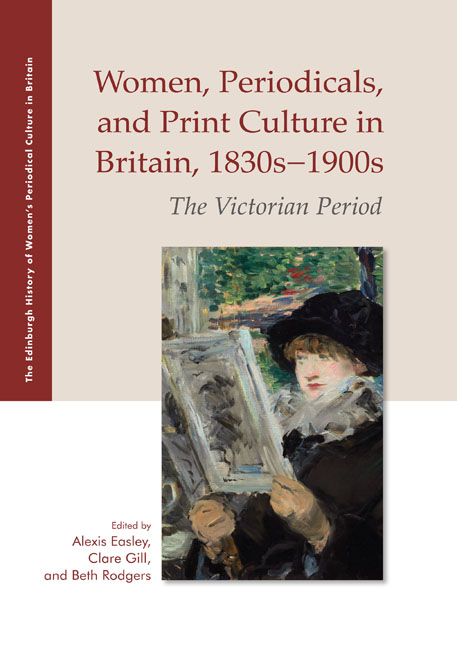Book contents
- Frontmatter
- Contents
- List of Illustrations
- Acknowledgments
- Introduction: Women, Periodicals, and Print Culture in the Victorian Period
- Part I (Re)Imagining Domestic Life
- Part II Constructing Modern Girls and Young Women
- Part III Women and Visual Culture
- Part IV Making Space for Women
- Part V Constructing Women Readers and Writers
- Part VI Intervening in Political Debates
- Intervening in Political Debates: Introduction
- 30 Brewing Storms of War, Slavery, and Imperialism: Harriet Martineau's Engagement with the Periodical Press
- 31 Mary Smith (1822–1889): A Radical Journalist under Many Guises
- 32 In Time of Disturbance: Political Dissonance and Subversion in Violet Fane's Contributions to the Lady's Realm
- 33 ‘Our Women in Journalism’: African-American Women Journalists and the Circulation of News
- 34 The Response of the Late Victorian Feminist Press to Same-Sex Desire Controversies
- 35 Wings and the Woman's Signal: Reputation and Respectability in Women's Temperance Periodicals, 1892–1899
- Notes on Contributors
- Index
- Plate section
33 - ‘Our Women in Journalism’: African-American Women Journalists and the Circulation of News
from Part VI - Intervening in Political Debates
Published online by Cambridge University Press: 25 October 2019
- Frontmatter
- Contents
- List of Illustrations
- Acknowledgments
- Introduction: Women, Periodicals, and Print Culture in the Victorian Period
- Part I (Re)Imagining Domestic Life
- Part II Constructing Modern Girls and Young Women
- Part III Women and Visual Culture
- Part IV Making Space for Women
- Part V Constructing Women Readers and Writers
- Part VI Intervening in Political Debates
- Intervening in Political Debates: Introduction
- 30 Brewing Storms of War, Slavery, and Imperialism: Harriet Martineau's Engagement with the Periodical Press
- 31 Mary Smith (1822–1889): A Radical Journalist under Many Guises
- 32 In Time of Disturbance: Political Dissonance and Subversion in Violet Fane's Contributions to the Lady's Realm
- 33 ‘Our Women in Journalism’: African-American Women Journalists and the Circulation of News
- 34 The Response of the Late Victorian Feminist Press to Same-Sex Desire Controversies
- 35 Wings and the Woman's Signal: Reputation and Respectability in Women's Temperance Periodicals, 1892–1899
- Notes on Contributors
- Index
- Plate section
Summary
IN 1891, I. GARLAND PENN published his landmark survey The Afro-American Press and Its Editors. At the time, he was a young writer who had contributed to the Richmond Planet, Virginia Lancet, Knoxsville Negro World, and New York Age. He embarked on The Afro-American Press in order ‘to promote the future welfare of Afro-American journalism by telling to its constituents the story of its heroic labors in their behalf’ (1891: 14). One chapter devoted to ‘Afro-American Women in Journalism’ includes profiles of nineteen women. Penn's inclusion of women writers underscored the collaborative work of African-American men and women in their effort to combat racial prejudice in the United States. As Penn himself acknowledged, his profiles of women journalists were not exhaustive but illustrated a diversity of women's writing, with many of the women writing with men and for male editors within the spaces of ‘men's’ newspapers.
For African-American women, this may actually have introduced them to larger audiences than they would have otherwise reached, and for some their gender may have been largely irrelevant to their day-to-day writing tasks, though for others writing about ‘women's issues’ was a focus of their work. As such, African-American women did not have to create separate spaces for their writing within a ‘women's press,’ but it is also an indication of the extent to which racial prejudice excluded black women from new spaces of expression created by white women of the socalled ‘women's press.’ By focusing on African-American journalism, this chapter speaks to the whiteness of the ‘women's press’ and extends our knowledge of black women writers working in Victorian print cultures in Britain. Focusing on histories of African-American women's journalism, I provide a transatlantic comparative perspective which opens up questions about the gendered and racialised models of print culture in Britain and within that, the women's press in Britain and its acknowledgment of black women in Britain and internationally.
Black Women Writing in the British Press
References to the ‘Afro-American press’ or other black publications as sources of news during the nineteenth century in the British press are unusual.
- Type
- Chapter
- Information
- Women, Periodicals and Print Culture in Britain, 1830s–1900sThe Victorian Period, pp. 528 - 541Publisher: Edinburgh University PressPrint publication year: 2019



